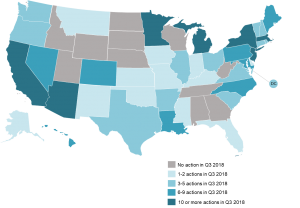The 50 States of Grid Modernization: 39 States + DC Took Action on Grid Modernization in Q3 2018
Raleigh, NC – (November 1, 2018) The N.C. Clean Energy Technology Center (NCCETC) released its Q3 2018 edition of The 50 States of Grid Modernization. The quarterly series provides insights on state regulatory and legislative discussions and actions on grid modernization, utility business model and rate reforms, energy storage, microgrids, and demand response.
The report finds that 39 states and the District of Columbia took actions related to grid modernization during Q3 2018 (see figure below), with the greatest number of actions relating to energy storage deployment (25), advanced metering infrastructure rules (22), grid modernization investigations (19), smart grid deployment (18), and distribution system planning (17).
A total of 276 grid modernization actions were taken during Q3 2018, representing a 50% increase over Q3 2017. New York, California and New Jersey took the greatest number of actions during the quarter, followed by Massachusetts, Arizona, Michigan and Minnesota.
Q3 2018 Legislative and Regulatory Action on Grid Modernization

The report discusses three trends in grid modernization activity taken in Q3 2018: (1) states considering a wide variety of metrics for utility performance incentives; (2) utility technology deployment proposals picking up, and (3) utilities eyeing comprehensive distributed energy resource programs for customers. Utilities filed proposals for at least $2.36 billion in investment in advanced metering infrastructure and smart grid deployment during the quarter.
“States and utilities are taking advantage of the opportunity to customize performance-based regulatory structures,” said Autumn Proudlove, lead author of the report and Senior Manager of Policy Research at NCCETC. “A wide array of performance incentive metrics are under consideration, addressing everything from peak reduction and customer service to grid investment and transportation electrification.”
The report notes the top five policy developments of Q3 2018 were:
- Massachusetts legislators adopting the country’s first clean peak standard
- Ohio and Oregon Commissions publishing grid modernization reports;
- PSE&G New Jersey proposing a $4 billion Clean Energy Future plan;
- Nevada regulators approving a distributed resource planning framework; and
- The Rhode Island Public Utilities Commission approving a settlement on National Grid’s Power Sector Transformation proposal.
“Some utilities are proposing new programs or rate designs that address distributed energy resources comprehensively, rather than creating separate technology-specific programs,” noted David Sarkisian, Senior Policy Analyst at NCCETC. “We will be watching to see how these programs evolve as distributed energy resources begin to interact with each on a larger scale.”
View the 50 States of Grid Modernization Q3 2018 Executive Summary
View and Purchase the 50 States of Grid Modernization Q3 2018 FULL Report
View other 50 States Reports – Solar, Grid Modernization and Electric Vehicles
ABOUT THE N.C. CLEAN ENERGY TECHNOLOGY CENTER
The N.C. Clean Energy Technology Center, as part of the College of Engineering at North Carolina State University, advances a sustainable energy economy by educating, demonstrating and providing support for clean energy technologies, practices and policies. It serves as a resource for innovative, sustainable energy technologies through technology demonstration, technical assistance, outreach and training. For more information about the N.C. Clean Energy Technology Center, visit: http://www.nccleantech.
MEDIA CONTACT: Shannon Helm, NCCETC, shannon_helm@ncsu.edu, 919-423-8340